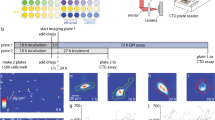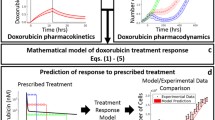Summary
The S-phase fraction (SPF) measured by flow cytometry of DNA and the thymidine labeling index (TLI) measured autoradiographically indicate the proportion of carcinoma cells currently synthesizing DNA and reflect the rate of proliferation. The TLI and SPF are lognormally distributed. The median TLI performed to maximize precursor uptake is near 5% (5 labeled carcinoma cells per 100), the mean near 7%, and the range from less than 1% to near 40%. Corresponding values for the SPF measured by DNA flow cytometry are slightly higher when appropriate measures are taken to reduce background debris counts and other artefacts. Residual elevation of SPF above TLI may result from S-phase arrested cells. Flow cytometric histograms show that clearly aneuploid cell lines exist in 50–80% of primary breast carcinomas. Aneuploid breast carcinomas have higher mean TLI than diploid breast carcinomas, and therefore proliferate more rapidly. They also more frequently lack estrogen receptor (ER). Carcinomas with minimal nuclear anaplasia, particularly those of tubular, mucinous, infiltrating lobular and adenocystic types have low TLI and SPF, whereas carcinomas with highly anaplastic nuclei, including medullary carcinomas, have high TLI and SPF. TLI and SPF correlate inversely with ER and PgR content, have no relationship to axillary lymph nodal status, and have a weak positive correlation with tumor size and a weak negative correlation with age. High TLI predicts a high risk of early relapse after primary therapy for both node-negative and node-positive carcinomas. Carcinomas that produce brain metastases have particularly high TLI. Current evidence suggests that high SPF and aneuploidy may prove to have prognostic significance like TLI.
Similar content being viewed by others
References
Steel GG: Growth Kinetics of Tumours. Clarendon Press, Oxford, 1977
Meyer JS: Growth and cell kinetic measurements in human tumors. Pathol Annu 16 (Part 2):53–81, 1981
Hamilton E, Dobbin J: The percentage labelled mitosis technique shows the mean cell cycle time to be half its true value in carcinoma NT. II. [3H] deoxyuridine studies. Cell Tissue Kinet 16:483–492, 1983
Taylor JH, Woods PS, Hughes WL: The organization and duplication of chromosomes using tritium-labeled thymidine. Proc Natl Acad Sci USA 43:122–128, 1957
Braylan RC: Flow cytometry. Arch Pathol Lab Med 107:1–6, 1983
Stenkvist B, Bengtsson E, Eriksson O, Jarkraus T, Nordin B, Westmann-Naeser S: Correlation between cytometric features and mitotic frequency in human breast carcinoma. Cytometry 1:287–291, 1981
Bloom HJG, Richardson WW: Histologic grading and prognosis in breast cancer. A study of 1409 cases of which 359 have been followed for 15 years. Br J Cancer 11: 359–377, 1957
Meyer JS: Cytokinetic analysis of breast carcinoma. Implications for adjuvant cytotoxic therapy of node-negative patients.In Blumenschein GR (ed): Current Controversies in Breast Cancer. Proceedings of the 26th Annual Clinical Conference on Cancer (in press)
Meyer JS, Hixon B: Advanced stage and early relapse of breast carcinomas associated with high thymidine labeling indices. Cancer Res 39:4042–4047, 1979
Meyer JS, Connor RE: In vitro labeling of solid tissues with tritiated thymidine for autoradiographic detection of S-phase nuclei. Stain Technol 52:185–195, 1977
Dörmer P, Brinkmann W, Born R, Steel GG: Rate and time of DNA synthesis of individual Chinese hamster cells. Cell Tissue Kinet 8:399–412, 1975
Meyer JS, Facher R: Thymidine labeling index of human breast carcinoma. Enhancement of in vitro labeling by 5-fluorouracil and 5-fluoro-2′-deoxyuridine. Cancer 39: 2524–2532, 1977
Gentili C, Sanfilippo O, Silvestrini R: Cell proliferation and its relationship to clinical features and relapse in breast cancers. Cancer 48:974–979, 1981
Meyer JS, Bauer WC, Rao BR: Subpopulations of breast carcinoma defined by S-phase fraction, morphology, and estrogen receptor content. Lab Invest 29:225–235, 1978
Meyer JS, Micko S, Craver JL, McDivitt RW: DNA flow cytometry of breast carcinoma after acetic-acid fixation. Cell Tissue Kinet (in press)
Straus MJ, Moran R, Muller RE, Wotiz HH: Estrogen receptor heterogeneity and the relationship between estrogen receptor and the tritiated thymidine labeling index in human breast cancer. Oncology 39:197–200, 1982
Silvestrini R, Diadone MG, Di Fronzo G: Relationship between proliferative activity and estrogen receptors in breast cancer. Cancer 44:665–670, 1979
Kute TE, Muss HB, Anderson D, Crumb K, Miller B, Burns D, Dube LA: Relationship of steroid receptor, cell kinetics and clinical status in patients with breast cancer. Cancer Res 41:3524–3529, 1981
Raber MN, Barlogie B, Latreille J, Bedrossian C, Fritsche H, Blumenschein G: Ploidy, proliferative activity and estrogen receptor content in human breast cancer. Cytometry 3:36–41, 1982
McDivitt RW, Stone KR, Meyer JS: A method for dissociation of viable human breast cancer that produces flow cytometric kinetic information similar to that obtained by thymidine labeling (submitted to Cancer Res)
Jakobsen A: The use of trout erythrocytes and human lymphocytes for standardization in flow cytometry. Cytometry 4:161–165, 1983
Olszewski W, Darzynkiewicz Z, Rosen PP, Schwartz MK, Melamed MR: Flow cytometry of breast carcinoma: I. Relation of DNA ploidy level to histology and estrogen receptor. Cancer 48:980–984, 1981
Taylor IW, Musgrove EA, Friedlander ML, Foo M, Hedley DW: The influence of age on the DNA ploidy levels of breast tumors. Eur J Cancer Clin Oncol 19:623–628, 1983
Bichel P, Poulsen HS, Andersen J: Estrogen receptor content and ploidy of human mammary carcinoma. Cancer 50:1771–1774, 1982
Haag D: Flow microfluorometric deoxyribonucleic acid (DNA) analysis supplementing routine histopathologic diagnosis of biopsy specimens. Lab Invest 42:85–90, 1982
Baisch H, Beck H-P, Christensen IJ, Hartmann NR, Fried J, Neal PN, Gray JW, Jett JH, Johnston DA, White RA, Nicolini C, Zeitz S, Watson JV: Comparison of evaluation methods for DNA histograms measured by flow cytometry.In Laerum OD, Lindmo T, Thorud E (eds): Flow Cytometry IV. Universitetsforlaget, Bergen, 1980, pp 152–158
Darzynkiewicz Z, Traganos F, Melamed MR: New cell cycle compartments identified by multiparameter flow cytometry. Cytometry 1:98–108, 1980
Allison DC, Yuhas JM, Ridolpho PF, Anderson S, Johnson TS: Cytophotometric measurement of the cellular DNA content of [3H]thymidine-labelled spheroids. Demonstration that some non-labelled cells have S and G2 DNA content. Cell Tissue Kinet 16:237–246, 1983
Auer GU, Caspersson TO, Wallgren AS: DNA content and survival in mammary carcinoma. Anal Quant Cytol 2:161–165, 1980
Atkin NB: Modal deoxyribonucleic acid value and survival in carcinoma of the breast. Br Med J 1:271–272, 1972
Wolley RC, Schreiber K, Koss LG, Karas M, Sherman A: DNA distribution in human colon carcinomas and its relationship to clinical behavior. JNCI 69:15–22, 1982
Meyer JS, Friedman E, McCrate M, Bauer WC: Prediction of early course of breast carcinoma by thymidine labeling. Cancer 51:1879–1886, 1983
Tubiana M, Pejovic JM, Renaud A, Contesso G, Chavaudra N, Gioanni J, Malaise EP: Kinetic parameters and the course of the disease in breast cancer. Cancer 47:937–043, 1981
Meyer JS, Rao BR, Stevens SC, White WL: Low incidence of estrogen receptor in breast carcinomas with rapid rates of cellular replication. Cancer 40:2290–2298, 1978
Sears HF, Janus C, Levy W, Hopson R, Creech R, Grotzinger P: Breast cancer without axillary metastases. Are there high risk biologic subpopulations? Cancer 50:1820–1827, 1982
Blamey RW, Bishop HM, Blake JRS, Doyle PJ, Elston CW, Haybittle JL, Nicholson RI, Griffiths K: Relationship between primary breast tumor receptor status and patient survival. Cancer 46:2765–2769, 1980
Hähnel R, Woodings T, Vivian AB: Prognostic value of estrogen receptors in primary breast cancer. Cancer 44:671–675, 1979
Shapiro CM, Schifeling D, Bitran JD, Desser RK, Rochman H, Michel A, Shapiro R, Evans R, Kozloff MF, Recant W, Billings AA: Prognostic value of the estrogen receptor level in pathologic stage I and II adenocarcinoma of the breast. J Surg Oncol 19:119–121, 1982
Samaan NA, Buzdar AU, Aldinger KA, Schultz PN, Yang K-P, Romsdahl MM, Martin R: Estrogen receptor: a prognostic factor in breast cancer. Cancer 47:554–560, 1981
Kinne DW, Ashikari R, Butler A, Menendez-Botet C, Rosen PP, Schwartz M: Estrogen receptor protein in breast cancer as a predictor of recurrence. Cancer 47:2364–2367, 1981
Howat JMT, Barnes DM, Harris M, Swindell R: The association of cytosol oestrogen and progesterone receptors with histological features of breast cancer and early recurrence of disease. Br J Cancer 47:629–640, 1983
Croton R, Cooke T, Holt S, George WD, Nicolson R, Griffiths K: Oestrogen receptors and survival in early breast cancer. Br Med J [Clin Res] 283:1289–1291, 1981
Crowe JP, Hubay CA, Pearson OH, Marshall JS, Rosenblatt J, Mansour EG, Hermann RE, Jones JC, Flynn WJ, McGuire WL and participating investigators: Estrogen receptor as a prognostic indicator for stage I breast cancer patients. Breast Cancer Res Treat 2:171–176, 1982
Allegra JC, Lippman ME, Simon R, Thompson EB, Barlock A, Green L, Huff K, Do HMT, Aitken SC, Warren R: Association between steroid hormone receptor status and disease-free interval in breast cancer. Cancer Treat Rep 63:1271–1277, 1979
Meyer JS, Lee JY: Relationships of S-phase fraction of breast carcinoma in relapse to duration of remission, estrogen receptor content, therapeutic responsiveness, and duration of survival. Cancer Res 40:1890–1896, 1980
Bertuzzi A, Diadone MG, Di Fronzo G, Silvestrini R: Relationship among estrogen receptors, proliferative activity and menopausal status in breast cancer. Breast Cancer Res Treat 1:253–262, 1981
Allegra JC: Methotrexate and 5-fluorouracil following tamoxifen and premarin in advanced breast cancer. Semin Oncol 10, No. 2 (Suppl 2):23–28, 1983
Brünner N, Spang-Thomsen M, Vindelov L, Nielson A: Effect of 17β-oestradiol on growth curves and flow cytometric DNA distribution of two human breast carcinomas grown in nude mice. Br J Cancer 47:641–647, 1983
Sutherland RL, Reddel RR, Green MD: Effects of oestrogens on cell proliferation and cell cycle kinetics. A hypothesis on the cell cycle effects of antioestrogens. Eur J Cancer Clin Oncol 19:307–318, 1983
Post J, Sklarew RH, Hoffman J: The proliferative patterns of human breast cancer cells in vivo. Cancer 39:1500–1507, 1977
Nordenskjöld B, Zetterberg A, Löwhagen T: Measurement of DNA synthesis by3H-thymidine incorporation into needle aspirates from human tumors. Acta Cytol 18: 215–221, 1974
Silvestrini R, Sanfilippo O, Tendesco G: Kinetics of human mammary carcinomas and their correlation with the cancer and the host characteristics. Cancer 34:1252–1258, 1974
Sklarew RJ, Hoffman J, Post J: A rapid in vitro method for measuring cell proliferation in human breast cancer. Cancer 40:2299–2302, 1977
Schiffer LM, Braunschweiger PG, Stragand JJ, Poulakos L: The cell kinetics of human mammary cancers. Cancer 43:1707–1719, 1979
Straus MJ, Moran RE: The cell cycle kinetics of human breast cancer. Cancer 46:2634–2639, 1980
Auer GU, Caspersson TO, Gustafsson SA, Humla SA, Ljung B-M, Nordenskjöld B, Silverswärd C, Wallgren AS: Relationship between nuclear DNA distribution and estrogen receptors in human mammary carcinomas. Anal Quant Cytol 2:280–284, 1980
Fossa SD, Marton PF, Knudsen OS, Kaalhus O, Bormer O, Vagge S: Nuclear Feulgen DNA content and nuclear size in human breast carcinoma. Hum Pathol 13:626–630, 1982
Olszewski W, Darzynkiewicz Z, Rosen PP, Schwarz MK, Melamed MR: Flow cytometry of breast carcinoma: II. Relation of tumor cell cycle distribution to histology and estrogen receptor. Cancer 48:985–988, 1981




